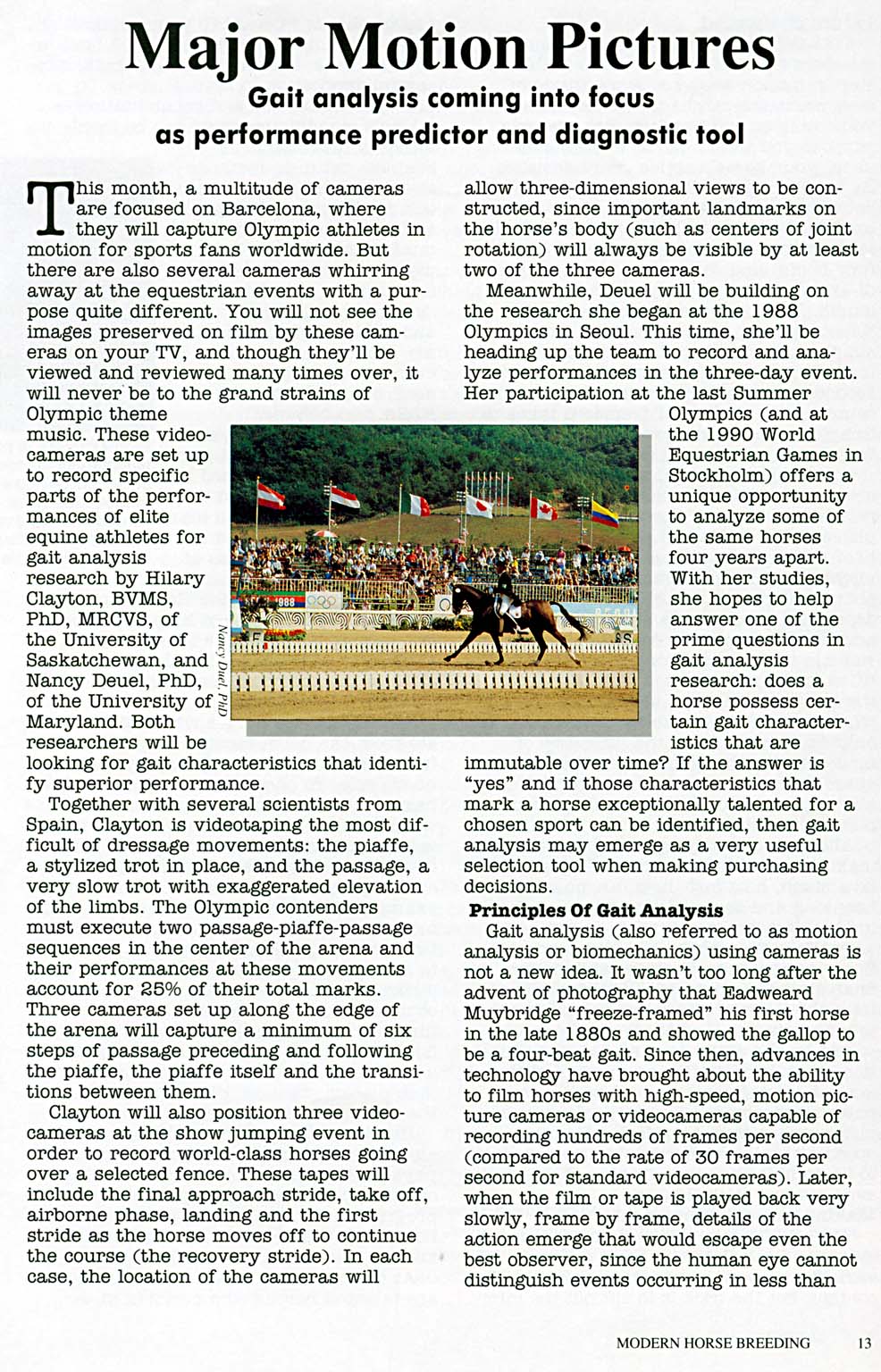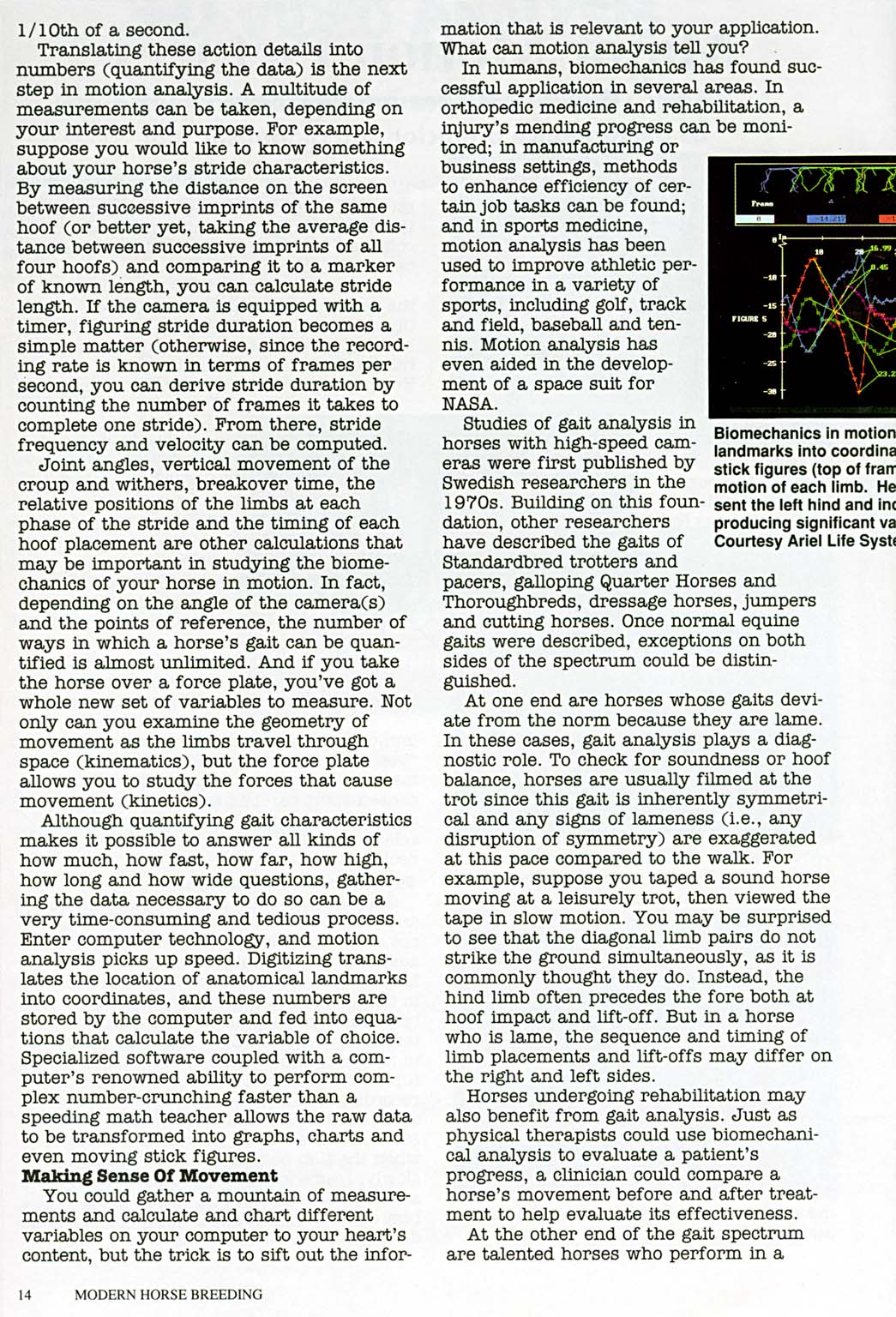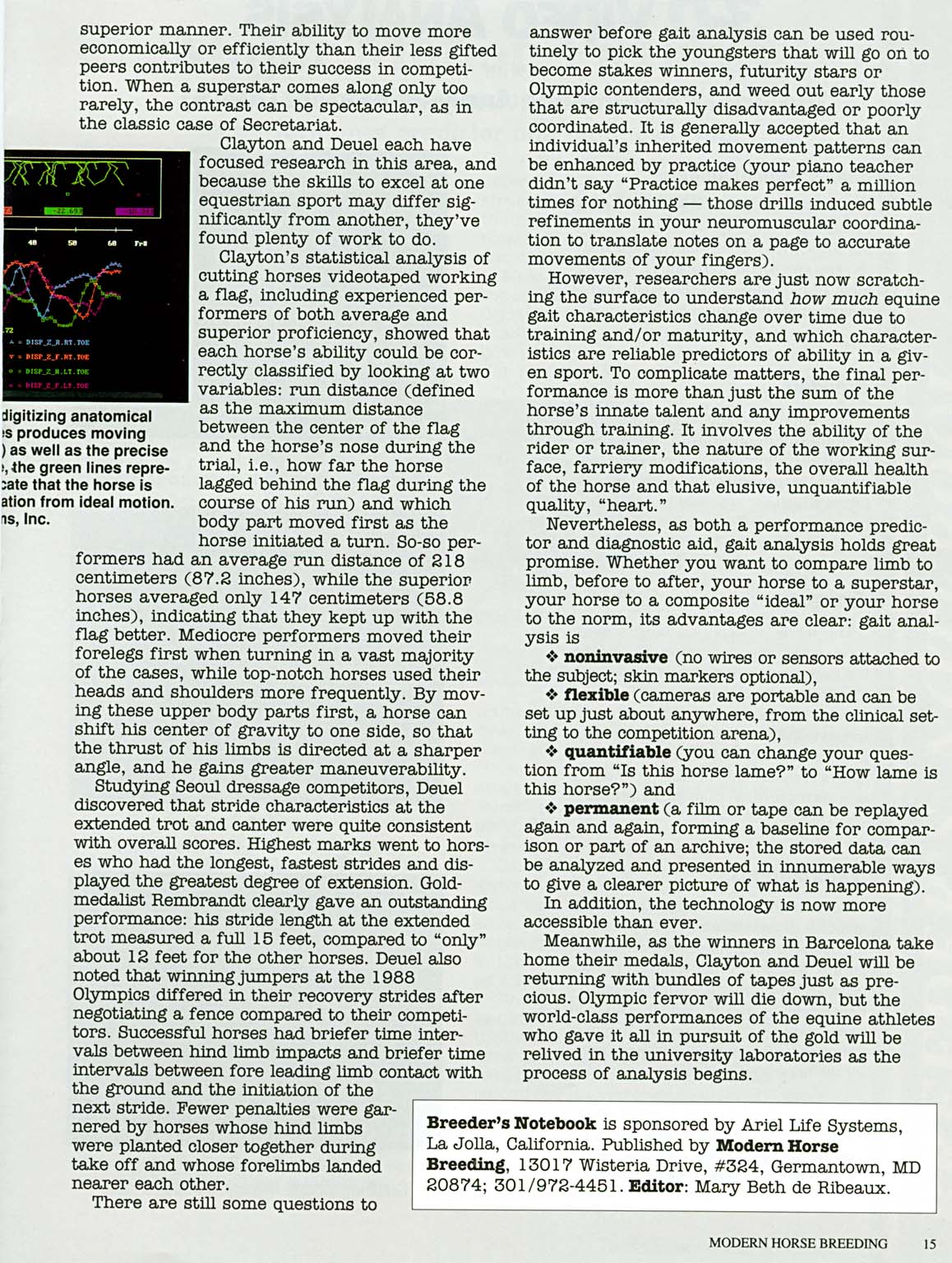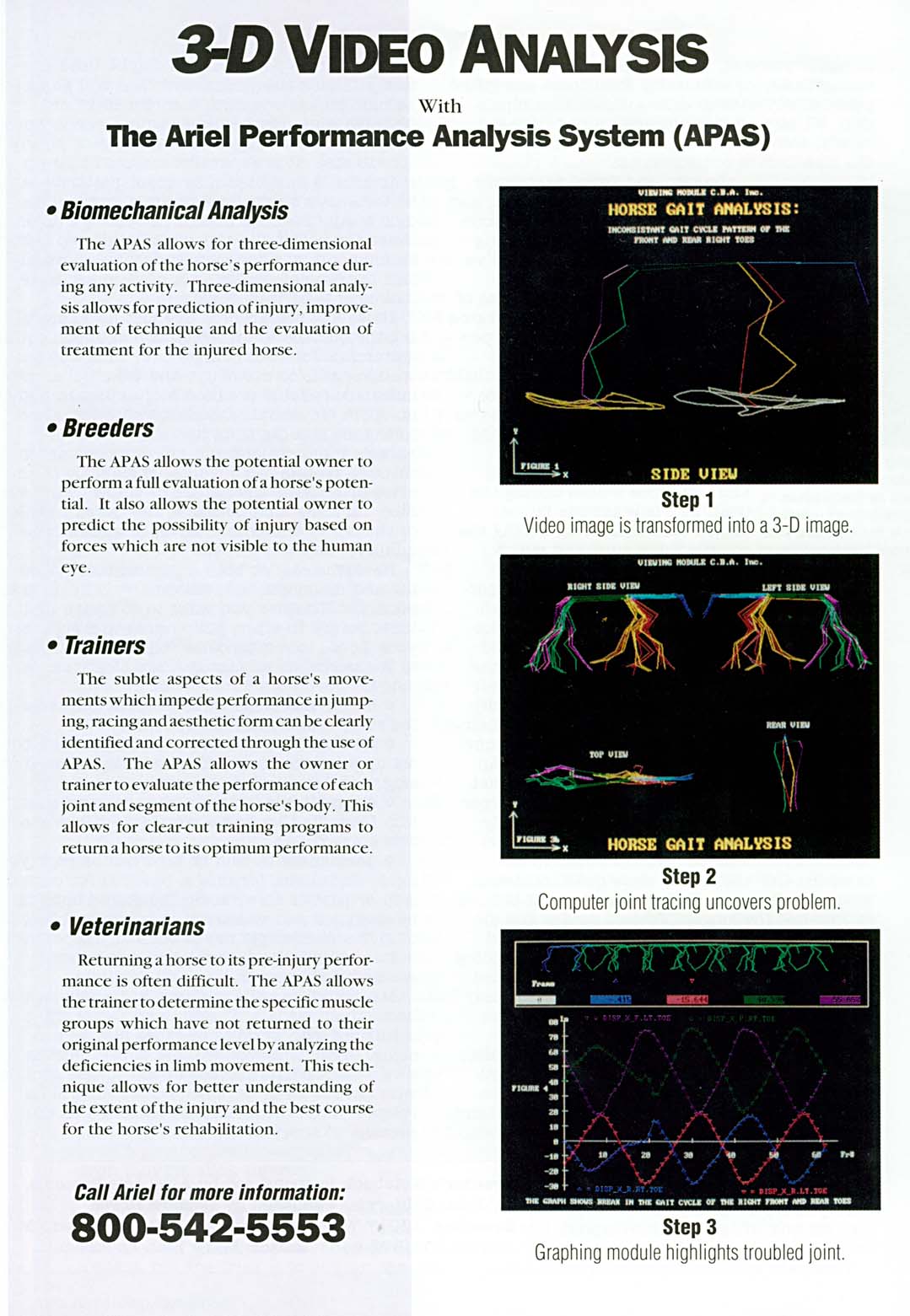Major Motion Pictures
Gait Analysis Coming into Focus as Performance Predictor and Diagnostic tool
By Hilary Clayton in Modern Horse Breeding on Tuesday, January 1, 1991
The article discusses the use of gait analysis as a performance predictor and diagnostic tool in equestrian sports. Researchers Hilary Clayton and Nancy Deuel are using video cameras to record specific parts of the performances of elite equine athletes at the Olympic games in Barcelona. They are looking for gait characteristics that identify superior performance. The data gathered will be used to answer questions in gait analysis research, such as whether a horse possesses certain gait characteristics that are immutable over time. If these characteristics can be identified, gait analysis could become a useful tool when making purchasing decisions. The article also discusses the principles of gait analysis, its applications in various fields, and its potential benefits and challenges.
Tip: use the left and right arrow keys
Major Motion Pictures
Gait analysis coming into focusas performance predictor and diagnostic tool
This month, a multitude of cameras are focused on Barcelona, where they will capture Olympic athletes in motion for sports fans worldwide. But there are also several cameras whirring away at the equestrian events with a purpose quite different. You will not see the images preserved on film by these cameras on your TV, and though they'll be viewed and reviewed many times over, it will never be to the grand strains of Olympic theme music. These videocameras are set up to record specific parts of the performances of elite equine athletes for gait analysis research by Hilary Clayton, BVMS, PhD, MRCVS, of the University of Saskatchewan, and Nancy Deuel, PhD, of the University of Maryland. Both researchers will be looking for gait characteristics that identify superior performance.
Together with several scientists from Spain, Clayton is videotaping the most difficult of dressage movements: the piaffe, a stylized trot in place, and the passage, a very slow trot with exaggerated elevation of the limbs. The Olympic contenders must execute two passage-piaffe-passage sequences in the center of the arena and their performances at these movements account for 25% of their total marks. Three cameras set up along the edge of the arena will capture a minimum of six steps of passage preceding and following the piaffe, the piaffe itself and the transitions between them.
Clayton will also position three videocameras at the show jumping event in order to record world-class horses going over a selected fence. These tapes will include the final approach stride, take off, airborne phase, landing and the first stride as the horse moves off to continue the course (the recovery stride). In each case, the location of the cameras will allow three-dimensional views to be constructed, since important landmarks on the horse's body (such as centers of joint rotation) will always be visible by at least two of the three cameras.
Meanwhile, Deuel will be building on the research she began at the 1988 Olympics in Seoul. This time, she'll be heading up the team to record and analyze performances in the three-day event. Her participation at the last Summer Olympics (and at the 1990 World Equestrian Games in Stockholm) offers a unique opportunity to analyze some of the same horses four years apart. With her studies, she hopes to help answer one of the prime questions in gait analysis research: does a horse possess certain gait characteristics that are immutable over time? If the answer is "yes" and if those characteristics that mark a horse exceptionally talented for a chosen sport can be identified, then gait analysis may emerge as a very useful selection tool when making purchasing decisions.
Principles Of Gait Analysis
Gait analysis (also referred to as motion analysis or biomechanics) using cameras is not a new idea. It wasn't too long after the advent of photography that Eadweard Muybridge "freeze-framed" his first horse in the late 1880s and showed the gallop to be a four-beat gait. Since then, advances in technology have brought about the ability to film horses with high-speed, motion picture cameras or videocameras capable of recording hundreds of frames per second (compared to the rate of 30 frames per second for standard videocameras). Later, when the film or tape is played back very slowly, frame by frame, details of the action emerge that would escape even the best observer, since the human eye cannot distinguish events occurring in less than
MODERN HORSE BREEDING 13
I/ 10th of a second.
Translating these action details into numbers (quantifying the data) is the next step in motion analysis. A multitude of measurements can be taken, depending on your interest and purpose. For example, suppose you would like to know something about your horse's stride characteristics. By measuring the distance on the screen between successive imprints of the same hoof (or better yet, taking the average distance between successive imprints of all four hoofs) and comparing it to a marker of known length, you can calculate stride length. If the camera is equipped with a timer, figuring stride duration becomes a simple matter (otherwise, since the recording rate is known in terms of frames per second, you can derive stride duration by counting the number of frames it takes to complete one stride). From there, stride frequency and velocity can be computed.
Joint angles, vertical movement of the croup and withers, breakover time, the relative positions of the limbs at each phase of the stride and the timing of each hoof placement are other calculations that may be important in studying the biomechanics of your horse in motion. In fact, depending on the angle of the camera(s) and the points of reference, the number of ways in which a horse's gait can be quantified is almost unlimited. And if you take the horse over a force plate, you've got a whole new set of variables to measure. Not only can you examine the geometry of movement as the limbs travel through space (kinematics), but the force plate allows you to study the forces that cause movement (kinetics).
Although quantifying gait characteristics makes it possible to answer all kinds of how much, how fast, how far, how high, how long and how wide questions, gathering the data necessary to do so can be a very time-consuming and tedious process. Enter computer technology, and motion analysis picks up speed. Digitizing translates the location of anatomical landmarks into coordinates, and these numbers are stored by the computer and fed into equations that calculate the variable of choice. Specialized software coupled with a computer's renowned ability to perform complex number-crunching faster than a speeding math teacher allows the raw data to be transformed into graphs, charts and even moving stick figures.
Making Sense Of Movement
You could gather a mountain of measurements and calculate and chart different variables on your computer to your heart's content, but the trick is to sift out the information that is relevant to your application. What can motion analysis tell you?
In humans, biomechanics has found successful application in several areas. In orthopedic medicine and rehabilitation, a injury's mending progress can be monitored; in manufacturing or business settings, methods to enhance efficiency of certain job tasks can be found; and in sports medicine, motion analysis has been used to improve athletic performance in a variety of sports, including golf, track and field, baseball and tennis. Motion analysis has even aided in the development of a space suit for NASA.
Studies of gait analysis horses with high-speed cameras were first published by Swedish researchers in the 1970s. Building on this foundation, other researchers have described the gaits of Standardbred trotters and pacers, galloping Quarter Horses and Thoroughbreds, dressage horses, jumpers and cutting horses. Once normal equine gaits were described, exceptions on both sides of the spectrum could be distinguished.
At one end are horses whose gaits deviate from the norm because they are lame. In these cases, gait analysis plays a diagnostic role. To check for soundness or hoof balance, horses are usually filmed at the trot since this gait is inherently symmetrical and any signs of lameness (i.e., any disruption of symmetry) are exaggerated at this pace compared to the walk. For example, suppose you taped a sound horse moving at a leisurely trot, then viewed the tape in slow motion. You may be surprised to see that the diagonal limb pairs do not strike the ground simultaneously, as it is commonly thought they do. Instead, the hind limb often precedes the fore both at hoof impact and lift-off. But in a horse who is lame, the sequence and timing of limb placements and lift-offs may differ on the right and left sides.
Horses undergoing rehabilitation may also benefit from gait analysis. Just as physical therapists could use biomechanical analysis to evaluate a patient's progress, a clinician could compare a horse's movement before and after treatment to help evaluate its effectiveness.
At the other end of the gait spectrum are talented horses who perform in a in Biomechanics in motion landmarks into coordina stick figures (top of frarr motion of each limb. He sent the left hind and Inc producing significant va Courtesy Ariel Life Systc
14 MODERN HORSE BREEDING
ligitizing anatomical !s produces moving
as well as the precise the green lines repre:ate that the horse is ation from ideal motion. is, Inc. superior manner. Their ability to move more economically or efficiently than their less gifted peers contributes to their success in competition. When a superstar comes along only too rarely, the contrast can be spectacular, as in the classic case of Secretariat.
Clayton and Deuel each have focused research in this area, and because the skills to excel at one .equestrian sport may differ significantly from another, they've round plenty of work to do.
Clayton's statistical analysis of cutting horses videotaped working a flag, including experienced pert ormers of both average and superior proficiency, showed that each horse's ability could be correctly classified by looking at two variables: run distance (defined as the maximum distance between the center of the flag and the horse's nose during the trial, i.e., how far the horse lagged behind the flag during the course of his run) and which body part moved first as the horse initiated a turn. So-so performers had an average run distance of 218 centimeters (87.2 inches), while the superior horses averaged only 147 centimeters (58.8 inches), indicating that they kept up with the flag better. Mediocre performers moved their forelegs first when turning in a vast majority of the cases, while top-notch horses used their heads and shoulders more frequently. By moving these upper body parts first, a horse can shift his center of gravity to one side, so that the thrust of his limbs is directed at a sharper angle, and he gains greater maneuverability.
Studying Seoul dressage competitors, Deuel discovered that stride characteristics at the extended trot and canter were quite consistent with overall scores. Highest marks went to horses who had the longest, fastest strides and displayed the greatest degree of extension. Goldmedalist Rembrandt clearly gave an outstanding performance: his stride length at the extended trot measured a full 15 feet, compared to "only" about 12 feet for the other horses. Deuel also noted that winning jumpers at the 1988 Olympics differed in their recovery strides after negotiating a fence compared to their competitors. Successful horses had briefer time intervals between hind limb impacts and briefer time intervals between fore leading limb contact with the ground and the initiation of the next stride. Fewer penalties were garnered by horses whose hind limbs were planted closer together during take off and whose forelimbs landed nearer each other.
There are still some questions toanswer before gait analysis can be used routinely to pick the youngsters that will go on to become stakes winners, futurity stars or Olympic contenders, and weed out early those that are structurally disadvantaged or poorly coordinated. It is generally accepted that an individual's inherited movement patterns can be enhanced by practice (your piano teacher didn't say "Practice makes perfect" a million times for nothing - those drills induced subtle refinements in your neuromuscular coordination to translate notes on a page to accurate movements of your fingers).
However, researchers are just now scratching the surface to understand how much equine gait characteristics change over time due to training and/or maturity, and which characteristics are reliable predictors of ability in a given sport. To complicate matters, the final performance is more than just the sum of the horse's innate talent and any improvements through training. It involves the ability of the rider or trainer, the nature of the working surface, farriery modifications, the overall health of the horse and that elusive, unquantifiable quality, "heart."
Nevertheless, as both a performance predictor and diagnostic aid, gait analysis holds great promise. Whether you want to compare limb to limb, before to after, your horse to a superstar, your horse to a composite "ideal" or your horse to the norm, its advantages are clear: gait analysis is
- noninvasive (no wires or sensors attached to the subject; skin markers optional),
- flexible (cameras are portable and can be set up just about anywhere, from the clinical setting to the competition arena),
- quantifiable (you can change your question from "Is this horse lame?" to "How lame is this horse?") and
- permanent (a film or tape can be replayed again and again, forming a baseline for comparison or part of an archive; the stored data can be analyzed and presented in innumerable ways to give a clearer picture of what is happening).
In addition, the technology is now more accessible than ever.
Meanwhile, as the winners in Barcelona take home their medals, Clayton and Deuel will be returning with bundles of tapes just as precious. Olympic fervor will die down, but the world-class performances of the equine athletes who gave it all in pursuit of the gold will be relived in the university laboratories as the process of analysis begins.
Breeder's Notebook is sponsored by Ariel Life Systems, La Jolla, California. Published by Modern Horse Breeding, 13017 Wisteria Drive, #324, Germantown, MD 20874; 301/972-4451. Editor: Mary Beth de Ribeaux.
MODERN HORSE BREEDING 15
3-D VIDEo ANALYSIS
With
The Ariel Performance Analysis System (APAS)
Biomechanical Analysis
The APAS allows for three-dimensional evaluation of the horse's performance during:uty activity. 'Three-tlinlensional analysis allows for prediction of injury, improvement of technique anti the evaluation 01' u�catnlent for the injured horse.
Breeders
TI tc APAS allows the potential o\yncr to perlitrni a full evaluation of "a horse's potential. It also alloys the potential owner to predict the pussihility of injure haled on forces which arc not Visible to the human eye.
Trainers
'I'hc subtle aspects of :t horse's ttu��cments which impede perfitrntancc in jumping. raring anti aesthetic firm can he clearly identified and corrected through the use of APAS. The APAS allows the owner or trainer to evaluate the perfornmance of each joint and segment oft he horse's both. This allow's for clear-cut training programs to return a horse to its optimum pert )rmancc.
Veterinarians
Returning a horse to its pre-injury performance is often difficult. The AI'AS alloys the trainer to determine the specific muscle groups which have not returned to their original performance level b analyzing the deficiencies in limb movement. This technique allows for better understanding of the extent of the injury and the best course for the horse's rehabilitation.




